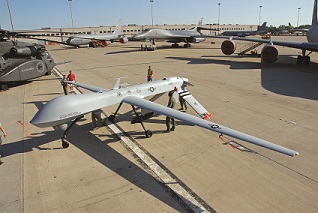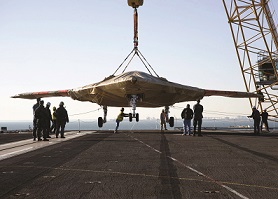
One hundred and ten years after Kitty Hawk, America’s aerospace and defense industry remains one of our nation’s most dynamic contributors to technological innovation, economic growth and the security and well-being of our people.
The aerospace and defense industry can be found in all 50 states, and has played a key role in our country’s modern development, in places such as Washington State’s Puget Sound area, Southern California, Wichita, Dallas/Ft. Worth, Huntsville and Florida’s space coast.
Opportunities for future development of infrastructure related to aerospace and defense abound. They include the continued development of commercial spaceports around the country and the FAA’s plan to identify six Unmanned Aircraft System (UAS) test sites as a precursor to the widespread introduction of UASs into the domestic airspace. Ongoing next-gen work to transform America’s aging ground-based air traffic control system to a highly efficient satellite-based system will also establish new opportunities and requirements.

Sequestration is also impacting the operations of our nation’s air transportation system, forcing the FAA to shut airport control towers, furlough air traffic controllers and freeze hiring of new controllers. The Department of Homeland Security will have to furlough security screeners and custom officials as well. The traveling public and cargo providers will experience delays as a result unless actions are taken to limit sequestration’s damage.
NASA will also suffer. As Aerospace Industries Association (AIA) warned in a study conducted by George Mason University economist Stephen Fuller, sequestration will hinder NASA’s ability to develop America’s next generation of launch vehicles and spacecraft, as well as put at risk over 20,000 NASA contractor jobs. The Fuller study noted that in addition to impacting the economies around NASA’s 10 geographically diverse centers, the cuts to NASA will damage those regions of the country with high concentrations of aerospace activity, better known as industry clusters. These clusters have been shown to promote economic efficiencies and specialization, encourage innovation and entrepreneurship, and drive prosperity for entire regions.
Even our weather forecasts may be impacted by sequestration, as NOAA will have to delay development of its next generation polar orbiting satellite because of the rigidity of the cuts.
While there has been talk in Congress of providing various agencies with relief from aspects of the sequestration cuts, AIA believes the best-possible solution is a long-term balanced, bipartisan budget deal that addresses entitlement and tax reforms as well as examines the federal budget in a more strategic, targeted way.
Even though the aerospace and defense industry is facing strong headwinds due to the budget situation, AIA is working with our members to take advantage of tremendous opportunities to grow our industry in the coming years.
We expect that exports will continue to be a bright spot for the industry. Last year U.S. aerospace products exports rose from $85 billion to $99 billion. Civil aviation sales comprised $86.8 billion of those export sales, a 15 percent gain over 2011, and military exports were $12.6 billion, for an impressive 25 percent gain over 2011.
On the commercial side, AIA is gearing up for the 2014 Export-Import Bank reauthorization to make sure U.S. commercial exports benefit from the same financial support enjoyed by foreign competitors.
We believe there is also a large opportunity for military export sales to grow even further.In March, President Obama initiated the process of moving parts and components for military aircraft and military engines off the U.S. Munitions Control list, making it easier for our companies to sell these products abroad to our close allies and partners while preventing access by countries of concern.We’re hopeful that the Munitions List reform process will be completed by the end of this year.

In that same context, we’re also hopeful that the U.S. government will assist our companies in exporting emerging technologies such as UASs, which today are captured by the overly broad restrictions of the Missile Technology Control Regime. Last year, we were able to get satellites and related equipment off the Munitions List, a major victory for the industry in overcoming a similar broad approach to technology control. This year we can get more done.
In 2013, we will also continue to present to defense planners ideas for billions of dollars in acquisition reforms that will help industry develop products more quickly for the defense customer and at less cost to the taxpayer.
We’ll also be pushing to make the Research and Development Tax Credit permanent. We know this credit is a valuable tool for giving companies the incentive to invest in the next great job-creating idea. However, the credit is estimated to rank 27th among 42 countries in terms of R&D tax incentive generosity. Countries like Germany even give outright grants to companies with promising R&D projects. So having to go back to Congress year after year just to keep this less-than-competitive level of tax credit alive doesn’t make sense in terms of keeping the U.S. competitive in the global race for R&D investment dollars.
In the months ahead we’ll work with the FAA to aid its rulemaking process to integrate UASs into the national airspace. Our agenda also includes pushing for progress on next-gen implementation and advocating for the commercial sector to have more opportunities to support U.S. civil and national security space missions. These are all areas in which we believe the advocacy of the aerospace and defense industry can and will make a difference.
In summary, despite the domestic budget challenges we face, the U.S. aerospace and defense industry remains strong, employing more than one million people across the nation, supporting 30,000 suppliers from all 50 states and indirectly supporting an additional two million jobs across all sectors. In the months ahead we will work hard to reverse sequestration, and to advance opportunities for our industry to contribute to national security, innovation and economic vitality.

